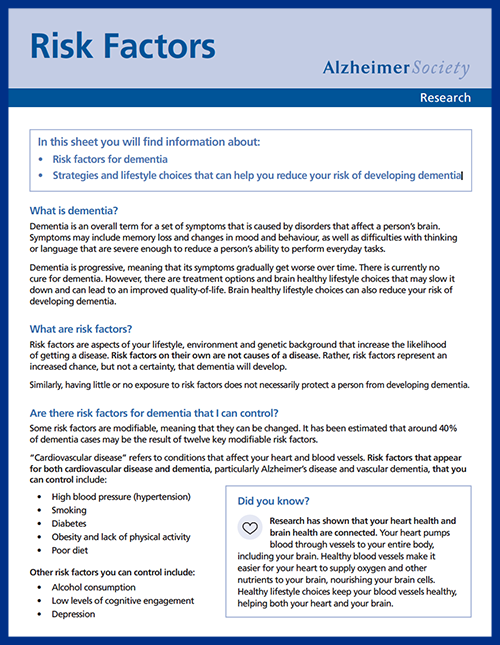Risk factors for dementia
When it comes to dementia, there are risk factors you can change, and risk factors you cannot. Learn about both types on this page, as well as unproven risks that need more evidence to be considered valid.

What are risk factors?
- Risk factors are aspects of your lifestyle, environment and genetic background that increase the likelihood of getting a disease.
- Risk factors on their own are not causes of a disease. Rather, risk factors represent an increased chance, but not a certainty, that dementia will develop.
- Similarly, having little or no exposure to risk factors does not necessarily protect a person from developing dementia.
There are some risk factors that can be changed, and some that cannot – read on to know which are which!
Read about risk factors for dementia in our downloadable, print-friendly infosheet.
This sheet also contains strategies and lifestyle changes that can help you reduce your risk of developing dementia.

Are there risk factors for dementia that I can control?
Some risk factors are modifiable, meaning that they can be changed. It has been estimated that around 40% of dementia cases may be the result of twelve key modifiable risk factors.
High blood pressure

People who have consistent high blood pressure (hypertension) in mid-life (ages 45 to 65) are more likely to develop dementia compared to those with normal blood pressure.
High blood pressure can increase the risk of developing dementia, particularly vascular dementia, because of its effect on the heart, the arteries, and blood circulation.
Smoking

The evidence is strong and consistent that smokers are at a higher risk of developing dementia vs. non-smokers or ex-smokers.
It’s never too late to quit! Smokers who quit can reduce their risk of developing dementia.
Diabetes

People with type 2 diabetes in mid-life (ages 45 to 65) are at an increased risk of developing dementia, particularly Alzheimer’s disease and vascular dementia.
Obesity
Obesity in mid-life (ages 45 to 65) increases the risk of developing dementia. Obesity also increases the risk of developing other risk factors such as type 2 diabetes.
Lack of physical activity

Physical inactivity in later life (ages 65 and up) increases the risk of developing dementia.
Poor diet

An unhealthy diet, high in saturated fat, sugar, and salt, can increase the risk of developing many illnesses, including dementia and cardiovascular disease.
High alcohol consumption

Drinking excessively (more than 12 drinks per week), can increase your risk of developing dementia.
Low levels of cognitive engagement

Cognitive engagement is thought to support the development of a
“cognitive reserve”. This is the idea that people who actively use their brains throughout their lives may be more protected against brain cell damage caused by dementia.
Depression

People who experience depression in mid- or later life have a higher risk of developing dementia. However, the relationship between depression and dementia is still unclear.
Many researchers believe that depression is a risk factor for dementia, whereas others believe it may be an early symptom of the disease, or both.
Traumatic brain injury

People who experience severe or repeated head injuries are at increased risk of developing dementia. Brain injuries may trigger a process that might eventually lead to dementia.
This particularly affects athletes in boxing, soccer, hockey, and football, which often have repeated head injuries.
Falls are the leading cause of traumatic brain injury. Falling is especially dangerous for older adults.
Hearing loss

Mild levels of hearing loss increase the risk of cognitive decline and dementia. Though it is still unclear how exactly it affects cognitive decline, hearing loss can lead to social isolation, loss of independence, and problems with everyday activities.
Social isolation

Social isolation can increase the risk of hypertension, coronary heart disease, depression, and dementia.
Staying socially active may reduce the risk of dementia. Social interaction may also help slow down the progression of the disease.
Air pollution

The relationship between air pollution and dementia is still unclear. However, it’s estimated that those living close to busy roads have a higher risk of dementia because they may be exposed to higher levels of air pollution from vehicle emissions.
It’s never too soon, or too late, to make changes that will maintain or improve your brain health. Learn more about managing some of these risk factors.
Are there risk factors for dementia that I cannot control?
Age

Dementia is not a normal part of aging. However, age is the strongest known risk factor for dementia. The older you become, the higher the risk:
- One in 20 Canadians over age 65 has Alzheimer’s disease, the most common form of dementia.
- After 65, the risk of developing Alzheimer’s disease doubles approximately every five years, with one in four Canadians over 85 having Alzheimer’s disease.
While rare, dementia can affect people under 65. This is known as young-onset dementia.
Gender

Women have a higher risk of developing Alzheimer’s disease than men. While the reasons for this are still unclear, some of the potential contributors include women generally living longer on average than men and changes in estrogen levels over many women's lifetimes.
For types of dementia other than Alzheimer’s disease, men and women have the same risk. There is not much data yet available on non-binary people and dementia, though some research is in progress.
For more information on how women may have different risks for dementia than men, watch this brainXchange webinar on understanding sex and gender differences in the brain.
Genetics

We don’t yet fully understand the role of genes in the development of dementia. We do know that most cases of Alzheimer’s disease are sporadic, meaning they do not run in families. Only rare instances of Alzheimer’s disease are inherited or familial, accounting for two to five percent of all cases.
Scientists have found over 70 genes that may increase the risk of developing Alzheimer’s disease. Three of these genes directly cause Alzheimer’s disease: PSEN1, PSEN2, and APP.
If a person has an alteration in any of these genes they will almost certainly develop familial Alzheimer’s disease, often well before the age of 65. If a parent has any of these changed genes, their children have a 50% chance of inheriting the disease.
The other genes associated with Alzheimer’s disease increase the risk, but don’t guarantee that Alzheimer’s disease will develop. Some other forms of dementia also have familial forms, such as some forms of frontotemporal dementia.
Check out our page on Genetic testing and Alzheimer's disease for more information.
Other risk factors
- Other medical conditions that can increase your chances of developing dementia include Parkinson’s disease, multiple sclerosis, chronic kidney disease, and HIV.
- Down syndrome and some other developmental disabilities may also increase your risk of developing dementia.
Now that you know what the risk factors are, find out more about maintaining a healthy lifestyle and brain.
Unproven risks
Some factors are alleged to cause dementia, but these claims have not been backed up with strong evidence. For them to be considered as valid risk factors, more studies need to be done that show conclusive links.
Here's what we currently know about these unproven risks for dementia:
Aluminum
Current research provides no convincing evidence that exposure to trace elements of aluminum is connected to the development of dementia.
Aluminum has been studied for over 40 years as a substance that might be linked to dementia. However, there have been many conflicting findings.
- Some studies show increased levels of trace elements of aluminum in the brains of people with dementia, while others do not.
- Studies have not found an increased incidence of dementia in people with occupational exposure to aluminum.
- Tea is one of the few plants whose leaves accumulate larger trace element amounts of aluminum that can seep into the brewed beverage. However, there is no evidence that dementia is more prevalent in cultures that typically drink large amounts of tea.
- Unfortunately, earlier animal studies focused on one animal that is particularly susceptible to aluminum poisoning, which has led to incorrect conclusions about the general effects of aluminum on the body.
Aluminum in cookware and other products
It would be difficult to significantly reduce exposure to aluminum simply by avoiding the use of aluminum products such as pots and pans, foil and beverage cans.
That's because the use of aluminum in these products only contributes to a very small percentage of the average person's intake of aluminum. It's important to remember that aluminum is an element found naturally in the environment and our bodies at levels that are normal and not harmful.
Aluminum in the environment
Aluminum has a non-metallic form that makes up eight per cent of the earth's surface. In small amounts, aluminum is referred to as "trace elements", and occur naturally in the foods we eat, in our drinking water and are even added to the water treatment process in some municipalities.
Trace elements of aluminum may also be found in:
- Many processed foods
- Cosmetics and personal hygiene products, such as deodorants and nasal sprays
- Some drugs in order to make them more effective or less irritating
- The air we breathe from dry soil, cigarette smoke, pesticide sprays and aluminum-based paint.
Aluminum in our bodies
Aluminum is also found naturally in our bodies, but its role is not fully understood. Very little of the aluminum taken in by a healthy individual is actually absorbed; most of it is flushed out by the kidneys.
More useful links and resources
Risk factors. Alzheimer Society of Canada. Read about risk factors for dementia in our downloadable, print-friendly infosheet. This sheet also contains strategies and lifestyle changes that can help you reduce your risk of developing dementia.
Understanding genetics and Alzheimer's disease. Alzheimer Society of Canada. In our downloadable, print-friendly infosheet, learn more about the role that genetics plays as a risk factor for dementia, and find out whether you should pursue genetic testing.
Risk factors and prevention. Alzheimer's Society UK. This comprehensive webpage from the Alzheimer's Society UK has some helpful nuggets of research and advice related to reducing your risk of dementia.
Tobacco use and dementia. World Health Organization (WHO), 2014. This report from the WHO details the evidence behind smoking tobacco as a risk factor for dementia.
Women and Dementia: Understanding sex/gender differences in the brain. brainXchange, 2018. This webinar discusses understandings of sex and gender, sex differences in Alzheimer’s disease, how the higher number of women with Alzheimer's may be due to both, and a discussion of the role of estrogen in the health of brain regions associated with Alzheimer’s disease. In partnership with the Alzheimer Society of Canada and the Canadian Consortium of Neurodegeneration in Aging (CCNA).
World Alzheimer Report 2014: Dementia and Risk Reduction. Alzheimer's Disease International (ADI), 2014. This is the most recent report from ADI that critically examines the evidence for the existence of modifiable risk factors for dementia.
Defy Dementia. A podcast by Baycrest that explores key dementia risk factors.
Last updated: October 17, 2023
